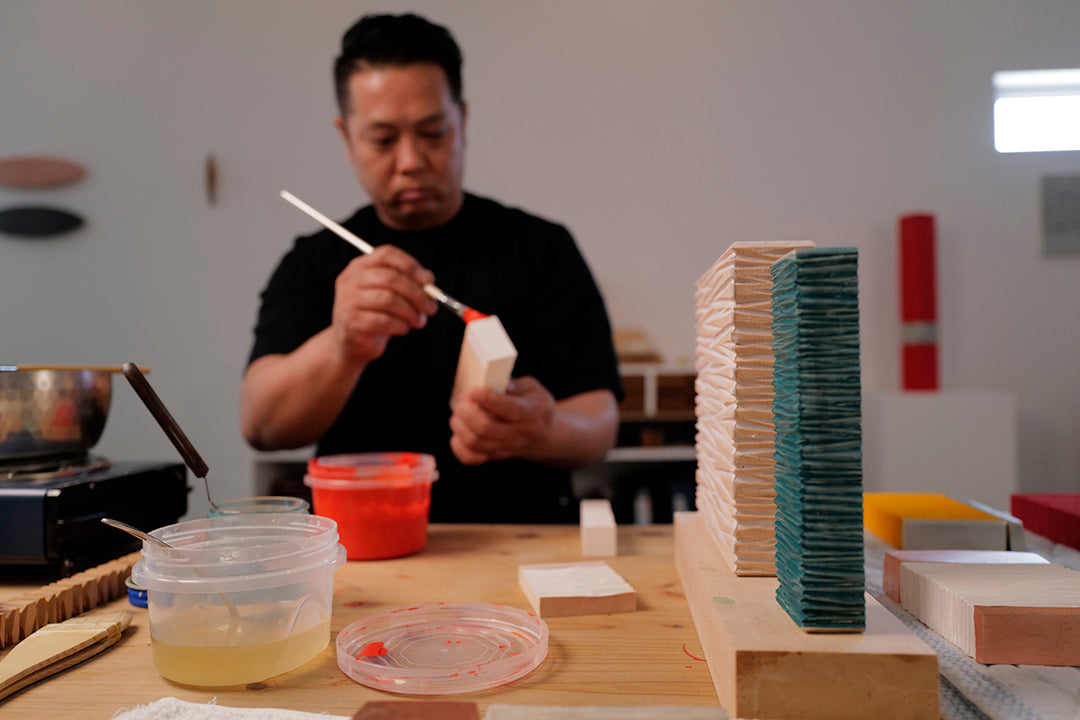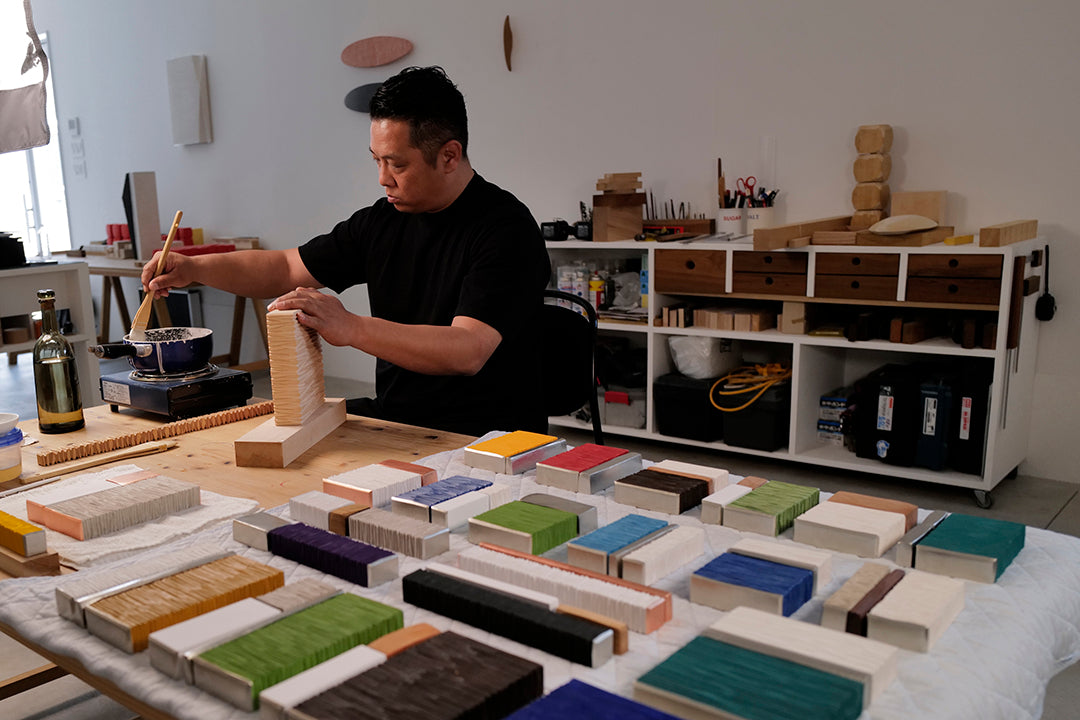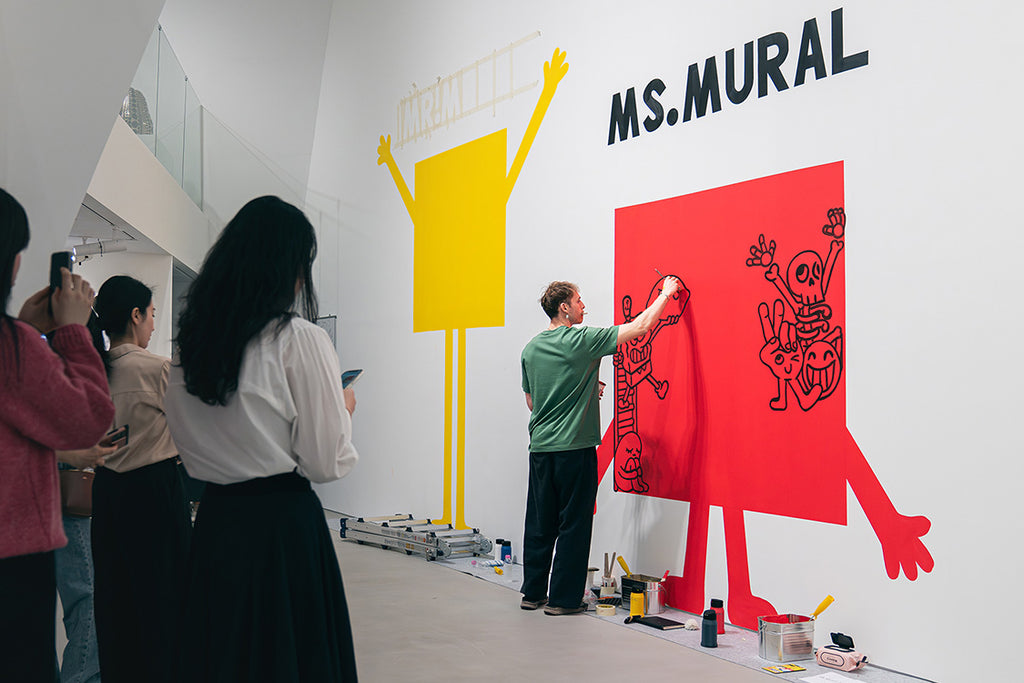ARTICLES
츠보타 마사유키의 조각 작품|자연재료와 생명의 리듬이 엮어낸 아름다움
2024.07.05
INTERVIEW

Masayuki Tsubota
Masayuki Tsubota's sculptures exhibit a tension-filled, minimalist form and vivid colors, showing different expressions depending on the viewing angle. The carefully crafted forms from natural materials seem to embody new life, spreading their presence throughout the entire space.
Born in 1976, Masayuki Tsubota studied sculpture at Osaka University of Arts and earned his master's degree. His works, which blend precision and harmony with nature, stimulate the viewer's senses. How are these deeply moving works created? Through an interview with the artist, we delve into the world of Tsubota's creations.
Receive the latest news and exclusive updates
Masayuki Tsubota's Exploration in Human and Spatial Relations

MASAYUKI TSUBOTA: Unknown Memories, 2024, Whitestone Gallery Seoul
- Could you tell us about the concepts and themes that are important to you in your work?
Tsubota: I have consistently focused on the connection between human physicality and space as a major theme.
I mainly use "wood" as my material, and by working as if in dialogue with the wood, I value the feeling that my breath and pulse as a creator are absorbed into the work. This process is also tied to the awareness that each piece is a work that can only be created now. The act of "carving with full concentration" itself becomes materialized as part of the expression, completing the work.
Sources of Inspiration: Masayuki Tsubota's Daily Inspirations

Masayuki Tsubota
- Where do you get the ideas and inspiration for your works?
Tsubota: Ideas come from various experiences and observations in daily life. For example, in Shinto shrines and Buddhist temples, there are various setups leading to sacred spaces that function as natural invitations. When visiting places lined with consecutive torii gates or open corridors, I notice that their continuity is connected with the flow of time. By visiting such places, I often get inspiration from their characteristics.
I also get inspiration from reading books, having conversations, or simply from a sudden thought. The desire to create the next work leads to sketches and drawings, which gradually take shape. When ideas don't progress smoothly, I engage in fieldwork, walking around various places. New perspectives and research often give rise to new series.
Masayuki Tsubota's Sympathy with Enku's Prayers and Creations

MASAYUKI TSUBOTA: Unknown Memories, 2024, Whitestone Gallery Seoul
- Are there any artists who have influenced you?
Tsubota: I feel great sympathy with Enku (1632-1695), a Japanese sculptor. Although he was a monk, he created numerous statues known as "Enku Buddhas." His works are often evaluated along with the word "prayer," but I wonder if he "couldn't help but create." The expressions imbued with prayer or spirit are part of human endeavor.
I also aim to create works that incorporate my breath and pulse, so I can strongly relate to how he might have felt a dialogue with nature and confronted human existence itself when carving wood.
The Appeal of Natural Materials: Breathing Life into Sculptures with Material and Color

At the artist's studio.
- Can you tell us about the materials and tools you use to create your sculptures?
Tsubota:I primarily use wood, but I also use stone and natural materials. In the initial stages of creation, I use large machines like chainsaws and table saws to cut out the material. As the work progresses, I use tools called "hand tools," such as chisels and planes, to perform more detailed work.
Finishing by hand is a very important process for me, and it's something I've realized repeatedly through creation. It feels as if the thoughts and energy infused into the work are amplified through the handcrafting process.

Masayuki Tsubota
- Your sculptures are not only attractive in form but also in color. What materials do you use for the colors?
Tsubota:The red, close to vermilion which I often use, is made with acrylic medium and pigments. I mix several types to get closer to the color that expresses the spirituality I envision.
I also use mineral pigments. While I sometimes mix mediums to create shades, the natural hues of mineral pigments differ significantly from acrylic paints, as they preserve the natural color tones.
Masayuki Tsubota Talks About the Joy of Creation

Group Exhibition: Invisible Dimension, 2024, Whitestone Gallery Beijing
- What is your favorite and most challenging process in creating your works?
Tsubota: The moment I first put the blade in is when I take the most care. Unlike modeling with clay, it involves carving out from a block, so there are moments where over-carving changes the piece entirely. The initial blade entry always brings a balance of tension and excitement.
- During the process of turning a block of wood into a finished work, are there moments when you feel the piece is becoming a "work"?
Tsubota: As I carve, there are moments when I feel "I have to stop here" or "I want to carve a bit more." I have certain rules within myself, but rather than putting everything into one work, I advance many pieces simultaneously. Deciding to stop this work here or to carve a bit more—this "time for contemplation" is also part of the creation process and is very important to me.

Masayuki Tsubota
Tsubota meticulously observes the movements of people and the use of space in urban settings, incorporating the energy and rhythms he feels into his work. The result is a precise, minimalist form that embodies the warmth and texture of nature, continually exploring the deep connection between humans and space.
Whitestone Gallery offers the opportunity to view Masayuki Tsubota's works online. Take this chance to immerse yourself in Tsubota's world of art.


